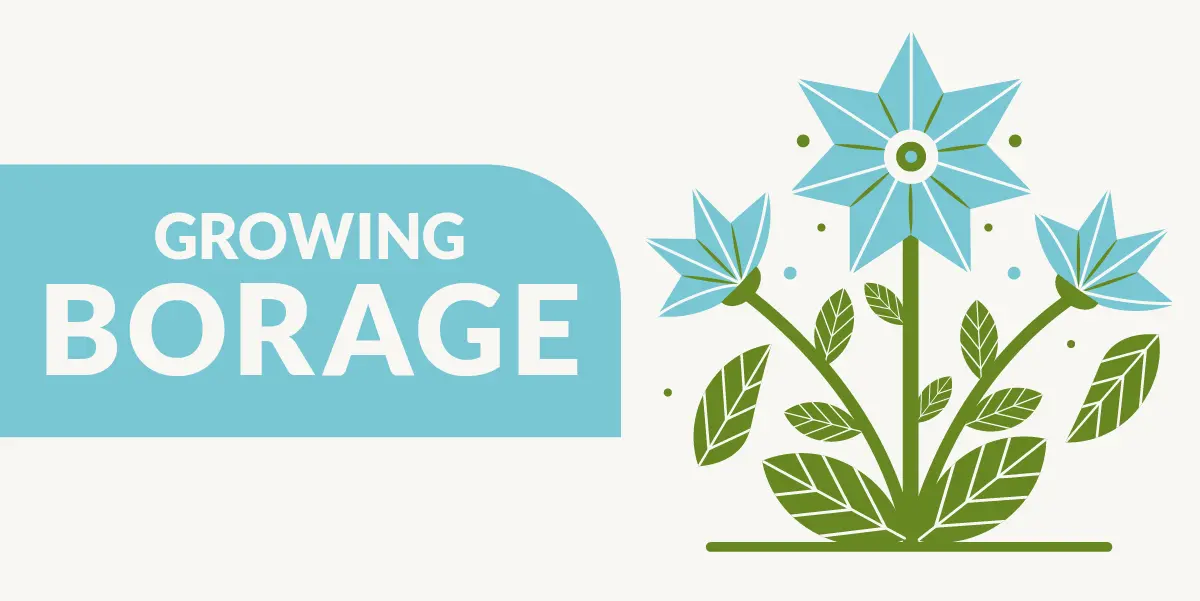Growing borage for companionship? We must be kidding, right?
We’re dead serious. You may not appreciate the companionship, but your tomatoes and strawberries do.
Among its many virtues, borage is a companion plant that repels garden pests and attracts native pollinators like bees and butterflies.
The borage herb, or star flower, hails from the Mediterranean, the cradle of so many good things in your garden. This hardy plant is more than a pretty flower — it’s a nutritional powerhouse.
Leaves and flowers contain high levels of beneficial compounds, such as gamma-linolenic acid (GLA), potassium, calcium, and magnesium. These nutrients are essential for healthy skin, hair, bones, and overall well-being.
Borage has been used for centuries in traditional medicine to treat various ailments, including respiratory issues, inflammation, and hormonal imbalances. It’s a pretty plant with a long history of health and beauty benefits.
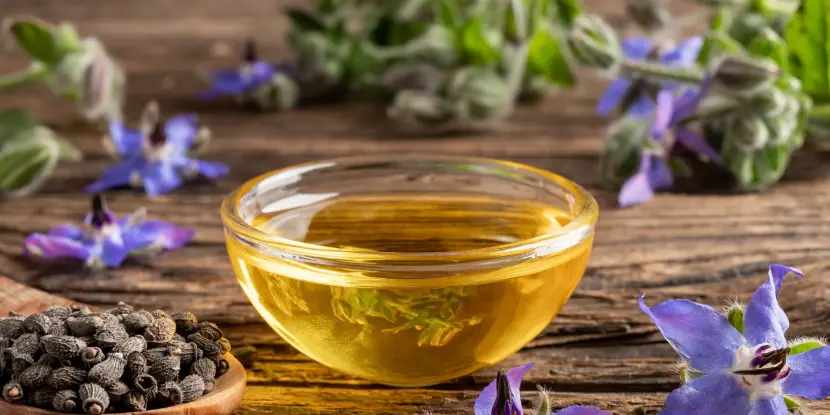
Steep borage leaves in hot water to make a healthy infusion.
Before we discuss the how-tos of growing borage, let’s explore its applications in skincare and health — including the health of your garden.
The Many Benefits of Borage
Skin Care
The GLA in borage soothes skin irritations, reduces inflammation, improves skin texture, and helps maintain moisture levels.
Here are some ways to incorporate borage into your skincare routine:
- Borage oil: Apply this topically to the skin or add it to homemade skincare products like serums, moisturizers, and facial oils.
- Borage tea: A simple infusion of borage leaves in hot water makes a refreshing and nourishing toner for the skin.
- Borage flower ice cubes: Freeze borage flowers in ice cube trays and use them as a natural cooling and calming treatment for sunburns or inflamed skin.
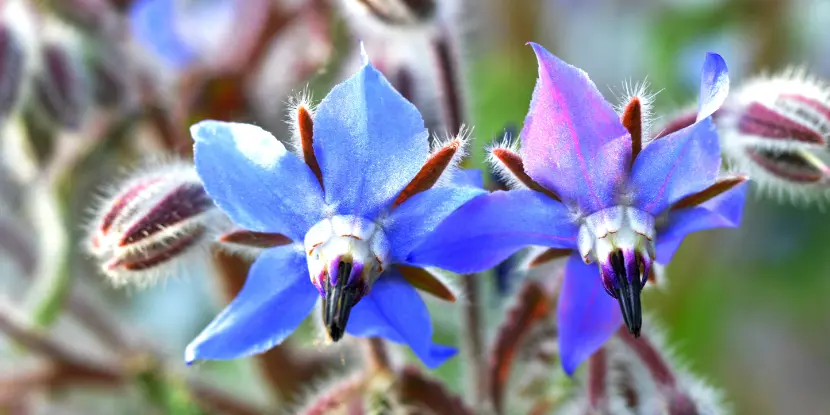
A close-up of borage “star flowers.”
Hair Care
- Borage oil: Massaging borage oil into the scalp can help stimulate hair growth and improve overall health.
- Borage tea rinse: Use a cooled borage tea infusion as a final rinse after shampooing to add shine and nourish your hair.
Overall Health
- Respiratory health: Borage has been used to alleviate symptoms of respiratory issues like coughs, colds, and bronchitis.
- Inflammation relief: Borage’s anti-inflammatory properties reduce joint pain and swelling associated with conditions like arthritis.
- Hormonal balance: Borage’s GLA content is a natural remedy for hormonal imbalances and menstrual cramps.
- Garden health: As mentioned earlier, borage is a natural pest repellent and pollinator attractor. Planting it alongside your vegetables and fruits can benefit your entire garden ecosystem.
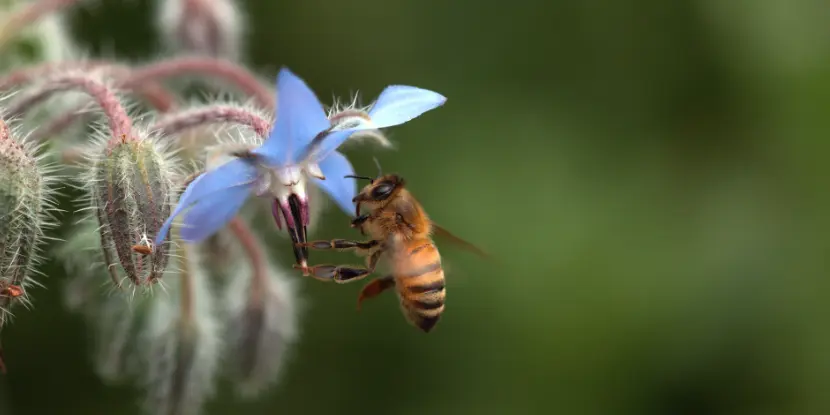
The borage plant repels pests while attracting beneficial insects like bees.
How to Grow Borage
Now that you know about the amazing benefits of borage, here are some cultivation tips:
- Seeds or seedlings: Borage can be grown from seeds sown directly into the ground or started indoors and transplanted later.
- Soil and sun requirements: Borage prefers well-draining soil with a neutral pH level. It thrives in full sun but can tolerate partial shade.
- Temperature: Borage can withstand both hot and cold temperatures. It may not bloom in extremely hot weather.
- Watering: Borage is drought-resistant, but make sure the soil stays moist. Overwatering can lead to root rot.
- Pruning: Regular pruning can encourage bushier growth and more flowers.
Harvesting & Using Borage
You can start harvesting borage leaves and flowers once the plant reaches about six inches high.
Leaves
- Pick young leaves for optimal tenderness and flavor.
- Use fresh or dried for teas, soups, salads, and other dishes.
Flowers
- Harvest flowers when they’re fully open for the most intense flavor.
- Add to salads, drinks, and desserts as a beautiful and edible garnish.
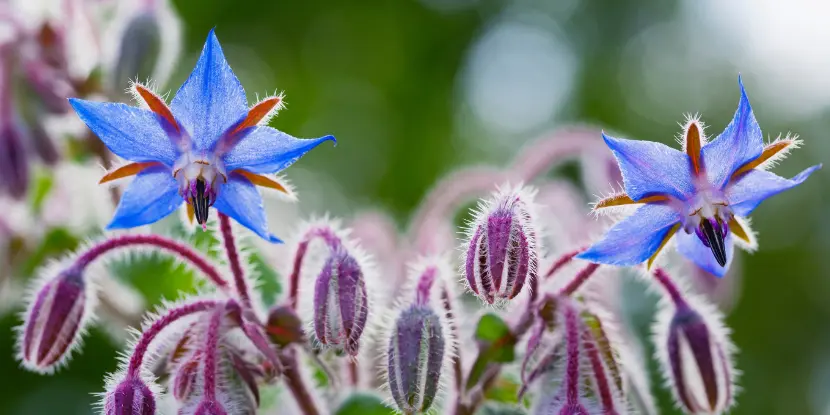
Borage flowers ripe for harvest.
Extracting Borage Oil
Cold Pressing Method
- Harvest and Clean Seeds: Collect borage seeds from the plant and clean them to remove debris.
- Pressing: Use a manual oil press to extract the oil from the seeds. This method maintains low temperatures, preserving the oil’s beneficial properties.
Infusion Method
- Prepare Ingredients: You’ll need borage seeds, a carrier oil (such as olive oil), a mason jar, and a double boiler.
- Mix and Heat: Place the borage seeds and carrier oil in a mason jar. Fill a pot with a few inches of water and place the mason jar in the pot, creating a double boiler setup. Heat on low for 1–2 hours, ensuring the water doesn’t boil away.
FAQs: Borage Care & Cultivation
Q: Can borage grow indoors?
You can grow borage indoors in a sunny spot, such as a south-facing window.
Q: Is borage safe to eat?
Both the flowers and leaves are edible, though it’s best to consume them in moderation.
Q: How do I store borage?
Fresh borage can be stored in the fridge for a few days. For more extended storage, consider drying the leaves or freezing the flowers.
Q: Can I use borage oil directly on my skin?
Borage oil can be applied directly to the skin. However, it’s always a good idea to do a patch test first to ensure you don’t have any sensitivities.
Q: Can borage grow in containers?
Yes. Use a pot with adequate drainage and fill it with well-draining soil. Water regularly to keep the soil moist but not waterlogged.
Q: What pests commonly affect borage?
Borage is relatively pest-resistant. However, it can sometimes attract aphids or leaf miners. To control these pests, apply natural remedies like neem oil or introduce beneficial insects like ladybugs.
Q: How do I propagate borage?
Collect seeds from mature flowers and sow them directly into the soil in early spring. You can also transplant seedlings started indoors.
Q: Does borage require fertilizer?
Borage doesn’t need heavy fertilization. However, adding compost or a balanced organic fertilizer before planting can promote healthy growth and flowering.
Q: Can borage be used as a cover crop?
Yes, borage can be used as a cover crop to improve the soil. Its deep roots help aerate the soil and add organic matter when tilled under, enriching the soil with nutrients.
Q: How long does borage take to grow from seed to harvest?
Borage typically takes 6 to 8 weeks to grow from seed to harvest. You can start harvesting leaves and flowers once the plant reaches about six inches tall.

